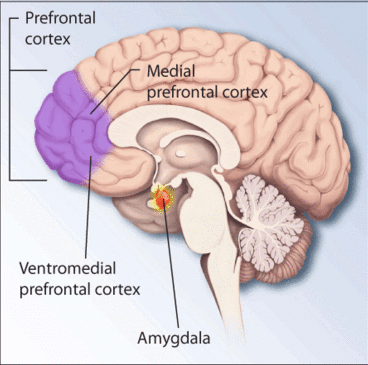|
Immersion Therapy
Immersion therapy is a psychological technique which allows a patient to overcome fears ( phobias), but can be used for anxiety and panic disorders. First a fear-hierarchy is created: the patient is asked a series of questions to determine the level of discomfort the fear causes in various conditions. Can the patient talk about the object of their fear, can the patient tolerate a picture of it or watch a movie which has the object of their fear, can they be in the same room with the object of their fear, and/or can they be in physical contact with it? Once these questions have been ordered beginning with least discomfort to most discomfort, the patient is taught a relaxation exercise. Such an exercise might be tensing all the muscles in the patient's body then relaxing them and saying "relax", and then repeating this process until the patient is calm. Next, the patient is exposed to the object of their fear in a condition with which they are most comfortable - such as merely tal ... [...More Info...] [...Related Items...] OR: [Wikipedia] [Google] [Baidu] |
Psychological
Psychology is the scientific study of mind and behavior. Psychology includes the study of conscious and unconscious phenomena, including feelings and thoughts. It is an academic discipline of immense scope, crossing the boundaries between the natural and social sciences. Psychologists seek an understanding of the emergent properties of brains, linking the discipline to neuroscience. As social scientists, psychologists aim to understand the behavior of individuals and groups.Fernald LD (2008)''Psychology: Six perspectives'' (pp.12–15). Thousand Oaks, CA: Sage Publications.Hockenbury & Hockenbury. Psychology. Worth Publishers, 2010. Ψ (''psi''), the first letter of the Greek word ''psyche'' from which the term psychology is derived (see below), is commonly associated with the science. A professional practitioner or researcher involved in the discipline is called a psychologist. Some psychologists can also be classified as behavioral or cognitive scientists. Some psycholog ... [...More Info...] [...Related Items...] OR: [Wikipedia] [Google] [Baidu] |
Phobia
A phobia is an anxiety disorder defined by a persistent and excessive fear of an object or situation. Phobias typically result in a rapid onset of fear and are usually present for more than six months. Those affected go to great lengths to avoid the situation or object, to a degree greater than the actual danger posed. If the object or situation cannot be avoided, they experience significant distress. Other symptoms can include fainting, which may occur in blood or injury phobia, and panic attacks, often found in agoraphobia. Around 75% of those with phobias have multiple phobias. Phobias can be divided into specific phobias, social anxiety disorder, and agoraphobia. Specific phobias are further divided to include certain animals, natural environment, blood or injury, and particular situations. The most common are fear of spiders, fear of snakes, and fear of heights. Specific phobias may be caused by a negative experience with the object or situation in early childhood. Soci ... [...More Info...] [...Related Items...] OR: [Wikipedia] [Google] [Baidu] |
Relaxation Exercise
A relaxation technique (also known as relaxation training) is any method, process, procedure, or activity that helps a person to relax; to attain a state of increased calmness; or otherwise reduce levels of pain, anxiety, stress or anger. Relaxation techniques are often employed as one element of a wider stress management program and can decrease muscle tension, lower the blood pressure and slow heart and breath rates, among other health benefits. People respond to stress in different ways, namely, by becoming overwhelmed, depressed or both. Yoga, QiGong, Taiji, and Pranayama that includes deep breathing tend to calm people who are overwhelmed by stress, while rhythmic exercise improves the mental and physical health of those who are depressed. People who encounter both symptoms simultaneously, feeling depressed in some ways and overexcited in others, may do best by walking or performing yoga techniques that are focused on strength. Background Research has indicated that remo ... [...More Info...] [...Related Items...] OR: [Wikipedia] [Google] [Baidu] |
Flooding (psychology)
Flooding, sometimes referred to as in vivo exposure therapy, is a form of behavior therapy and desensitization—or exposure therapy—based on the principles of respondent conditioning. As a psychotherapeutic technique, it is used to treat phobia and anxiety disorders including post-traumatic stress disorder. It works by exposing the patient to their painful memories, with the goal of reintegrating their repressed emotions with their current awareness. Flooding was invented by psychologist Thomas Stampfl in 1967. It is still used in behavior therapy today. Flooding is a psychotherapeutic method for overcoming phobias. In order to demonstrate the irrationality of the fear, a psychologist would put a person in a situation where they would face their phobia. Under controlled conditions and using psychologically-proven relaxation techniques, the subject attempts to replace their fear with relaxation. The experience can often be traumatic for a person, but may be necessary ... [...More Info...] [...Related Items...] OR: [Wikipedia] [Google] [Baidu] |
Behavior Therapy
Behaviour therapy or behavioural psychotherapy is a broad term referring to clinical psychotherapy that uses techniques derived from behaviourism and/or cognitive psychology. It looks at specific, learned behaviours and how the environment, or other people's mental states, influences those behaviours, and consists of techniques based on behaviorism’s theory of learning: respondent or operant conditioning. Behaviourists who practice these techniques are either behaviour analysts or cognitive-behavioural therapists. They tend to look for treatment outcomes that are objectively measurable. Behaviour therapy does not involve one specific method, but it has a wide range of techniques that can be used to treat a person's psychological problems.Antony, M.M., & Roemer, E. (2003). Behaviour therapy. In A.S. Gurman & S.B. Messer (Eds.), Essential psychotherapies (2nd ed., pp. 182-223). New York: Guilford. Behavioural psychotherapy is sometimes juxtaposed with cognitive psychotherapy. Whi ... [...More Info...] [...Related Items...] OR: [Wikipedia] [Google] [Baidu] |

